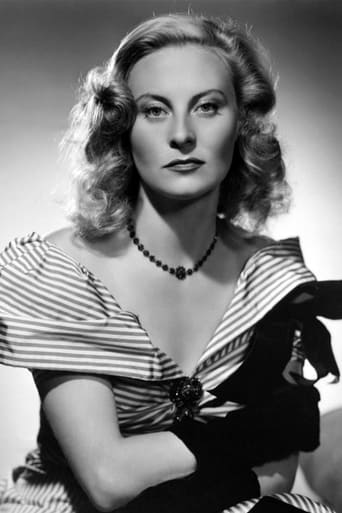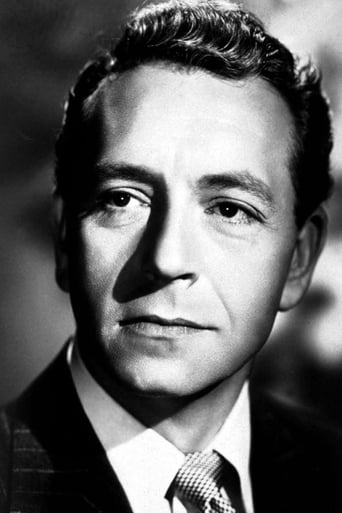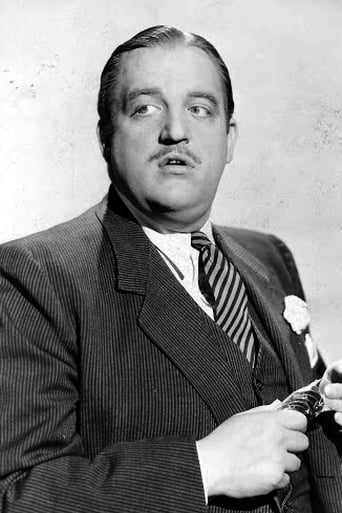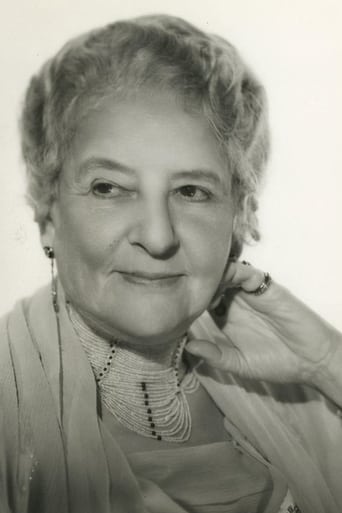Pluskylang
Great Film overall
Dorathen
Better Late Then Never
Gutsycurene
Fanciful, disturbing, and wildly original, it announces the arrival of a fresh, bold voice in American cinema.
Verity Robins
Great movie. Not sure what people expected but I found it highly entertaining.
JohnHowardReid
Copyright 23 January 1942 by RKO Radio Pictures, Inc. New York opening at the Rivoli: 24 January 1942. U.S. release: 9 January 1942. Australian release: 27 August 1942. 8,400 feet. 93 minutes.
SYNOPSIS: Stranded in Paris, five Allied flyers - one of them badly wounded - attempt to escape the Nazis.NOTES: Hollywood debut (note that word "Hollywood", not "English language", not "American film") of Paul Henreid. English language debut of Michele Morgan. Alan Ladd's last film before This Gun For Hire catapulted him to major stardom.COMMENT: After a dramatically inventive opening (utilizing stock footage and the finger-doll chorus from The Gay Divorcee singing "Don't Let It Bother You" by Harry Revel and Mack Gordon), the film starts in fine thriller style with a brilliant series of fast-action, silhouettes-in-the mist tableaux from cinematographer Russell Metty. Nor does the pace let up when the scene shifts to Paris and Michele Morgan is finally introduced. Although not over-flatteringly photographed, she gives a poignant performance which rivals both in intensity and power Laird Cregar's elegantly vicious Gestapo chief. A pity Paul Henried (yes, he does occasionally spell his name that way) cannot match either of these players in charismatic fascination. True he acts fairly convincingly, even with sincerity, but young Alan Ladd (admittedly in a showy role) runs rings around him. Alexander Granach (of Warning Shadows and Nosferatu fame) also has one of the best roles of his career here - as a postage stamp! Doubtless the scriptwriters thought up his wonderful piece of business with the handkerchief, the gun and the little girl, but he plays it admirably, like a sort of latter-day Louis Wolheim. We must also commend John Abbott who has an effective cameo as an about-to-be-executed spy.It's correct as some critics have commented that quite a few of the script's details don't quite ring true. We could even add to the list, for example the Bible that Mitchell brings to the cell looks remarkably thin for a Catholic Bible. And it's 99.9% unlikely that any priest - or even a bishop or cardinal - would recognize the obscure verses from Proverbs and Job that Abbott asks for (even though these do allow the writers to get in the obligatory Old Testament quotes that Hollywood films are famous for). I also marvel at Henreid's proficiency in Latin. Even a priest would be hard pressed to put words to paper with such celerity.Pay no mind to me. What if the script is full of holes? Stevenson's driving direction of the fast-paced plot leaves little time for reflection on these matters. And when Morgan, Ladd, Cregar, Abbott and company are on screen, and when that screen is flooded or shadowed with Metty's lights, and when the sets are so artistically atmospheric, there's simply no time, no inclination whatever, to dissect trivialities. I'm inclined to agree with Bennett (below).OTHER VIEWS: I love Joan of Paris. It's my favorite of all the pictures I've ever been connected with. - Charles Bennett.Michele Morgan's first American (and indeed English-language) film starts off rather inventively with a musical clip from Gay Divorcee cut into a blank screen with narration off-camera and some strikingly composed and lit images with Nazi soldiers shrouded by fog and a superbly lit sequence in a church with shadows and silhouettes atmospherically built up by a background of choral music. In fact the directorial and photographic imaginativeness does not fade until, oddly enough, the entrance of Miss Morgan herself. It's as if the director thought that once the stage was set for her and she was actually on-camera she would take the whole weight of the film on her shoulders, save for some assistance from the delightfully and suavely evil presence of Laird Cregar as the Gestapo chief and the late entrance of May Robson giving a rather exaggerated portrayal of a schoolteacher/spy (but they are neither in the film all that much). Miss Morgan is rather poorly and unattractively photographed too and it seems as if the scriptwriter has really had to scratch his head to provide her with enough dialogue to justify her star billing. She has a ridiculous little monologue to her patron saint (incidentally she speaks English perfectly with hardly the slightest trace of an accent) and shares a lot of unconvincing and highly implausible romantic dialogue with Paul Henried who has a sort of precursor (in two senses) of his role in Casablanca. Presumably Alan Ladd had already been picked for stardom in This Gun For Hire when this film was being made or edited which explains the large number of close-ups he enjoys for so small a part (and not very convincingly enacted either!). There is a nice study by Alex Granach who plays an almost comic Gestapo agent with the talents of a leech (the extended series of sequences in which Henried tries to lose him is almost comic and seems to have been treated in a somewhat ambivalent fashion by Stevenson). Art direction, music scoring as well as photography, are plus factors and the film has been realized on a sizable budget. - John Howard Reid writing as George Addison.
st-shot
Primarily a propaganda film to remind the French and English they are allies in the fight against fascism during WW 2 Joan of Paris has some fine performances to go along with some excellent atmospherics provided by Russell Metty's photography to bring more suspense than the usual call to arms film of the day.A group of downed RAF fliers find themselves trapped in Paris attempting to evade the Gestapo and make contact with the French underground. The commander (Paul Henreid) unwittingly enlists and puts in harm's way a cafe waitress (Michele Morgan) to help the group but a suave Gestapo chief (Laird Cregar) is on to their game and he bides his time waiting to pounce in order to catch all the airmen in his net.Craigar as the grape peeling Gestapo head steals the picture but Henried and Morgan have a good chemistry with each other while Thomas Mitchell and May Robson bolster the supporting cast which also features Allan Ladd in his last film before stardom in This Gun for Hire and a convincing Hans Conreid (uncredited) as a sadistic Gestapo agent.Metty's photography serves some of the cat and mouse moments well, especially one that culminates at a Turkish bath and director Robert Stevenson ably demonetize the enemy while attempting to impress the audience that in spite of England's earlier bombing of the French fleet in 1940 they remained shoulder to shoulder in their cause to defeat Nazi Germany. Also deserving mention is the schoolboy protest where the students break into La Marsaiellse as Nazi's open fire on the fleeing underground and flyer. Predating the classic Casablanca moment later in the year it may not be of the same quality but it more than does its patriotic duty for the cause.
bkoganbing
Joan of Paris is best known for the joint debut of both Michelle Morgan and Paul Henreid on the American cinema. Henreid is a member of the Free French flying with the RAF and he and the crew are shot down over occupied France. Henreid and the group including a wounded Alan Ladd make their way to Paris where he tries to contact either the French underground or any British intelligence operatives.When Henreid came, he came to stay in America, becoming a citizen years later. Morgan made a few films and went back to France after the war where she resumed her star status. She and Jean Gabin are probably the two most well known French players who managed to flee the occupation and continue their careers on foreign soil.Henreid displays all the charm later put to full advantage in Casablanca and Now Voyager. Their romance is tender and all too tragically brief. Like Casablanca, Henreid wants to get back in the fight. Morgan, who's patron saint is Joan of Arc, will sacrifice all to aid him.The best performance in this film is that of 20th Century Fox loan out to RKO, Laird Cregar. Cregar, a clever and epicene occupier who's bulk suggests Herman Goering, is the relentless pursuer of the downed fliers. Alan Ladd scored a notable success as the kid flier although he tries at times to affect a British accent. They should have just made him Canadian as they did all the other American actors who played in British locations and situations. It wasn't as bad as Gregory Peck's in The Paradine Case though.Joan of Paris is a good, but routine product from RKO, one of the minor studios. In her next film Morgan would be opposite that American icon making his feature film role debut, Frank Sinatra in Higher and Higher. Still she and Henreid acquit themselves well, albeit in a minor key.
Neil Doyle
This little known film released the same year as CASABLANCA is a minor gem among Hollywood's wartime romances, teaming Paul Henried and Michele Morgan very effectively in the leads. Despite some odd casting choices (Thomas Mitchell as a French priest) or Henried as a French squadron leader based in England, it tells an absorbing espionage tale of the French resistance against the Nazis. Released by RKO, it seems more like one of the typical Warner Bros. melodramas popular at that time. Even some of the supporting cast seem like Warner contract players--notably John Abbot as a prisoner about to be executed and May Robson. A tale of one woman's noble sacrifice to aid members of an RAF squadron in their attempt to return to England, it holds the viewer with its shadowy B&W photography and creates an atmosphere suggesting a French village during World War II. Paul Henried is excellent as the man trying to rid himself of a Gestapo agent who "sticks to him like a postage stamp".
Other notable roles are filled by Laird Cregar, as a cunning Gestapo who snares Henried in his trap, and Alan Ladd as "Baby", one of the downed flyers who is injured. Ladd was on the brink of major stardom and his performance here shows why--it's a brief but memorable supporting role. Shortly after this film, he was signed for his star-making role in "This Gun for Hire".Well worth watching...an absorbing example of a well scripted and directed wartime espionage film with only an occasional false note that does no major harm to the movie. The scene with the children in the schoolroom lacks credibility throughout.





